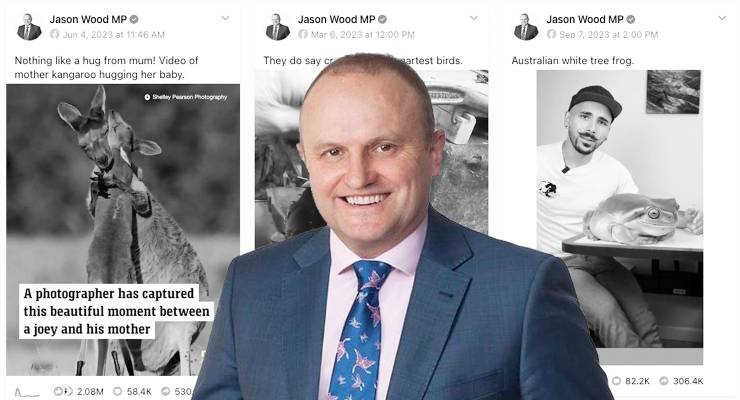
A French Bulldog riding a skateboard. A bird whistling “Jingle Bells” in the face of a sleepy Chihuahua. A baby sloth reuniting with its mother after a fire.
These adorable and hilarious scenarios are the subjects of viral videos regularly posted to the Facebook page of Liberal Party member for La Trobe Jason Wood.
These posts — seemingly ripped without permission from other sources like news.com.au, UNILAD and viral animal video Facebook page Furry Tails — appear to be part of a strategy that has helped Wood grow one of the biggest Facebook audiences of any Australian politicians.
But while an expert said the strategy is helping Wood grow his digital reach, they also warned it might not help him persuade any voters.
Wood has been a prolific user of Facebook. In 2023, his Facebook page posted 2,000 times in total — a monthly average of 147 times.
A glance at the page shows a fairly ordinary mix of posts from a politician: celebrations of various holidays, updates from his family, and attacks on his political opponents.
Sprinkled among these posts are videos and images best described as “Facebook bait”: short, softly edited, feel-good pieces of content of animals doing something cute or remarkable.
The response to these videos is eye-popping. In 2023, Wood’s videos on Facebook were viewed more than 251 million times. While a few videos are original content from Wood showing him talking to the camera, the vast majority of them are of the animal variety.
Wood’s animal videos were by far the most popular pieces of content on his page in 2023. They make up the top 50 pieces of content as counted by total engagements (likes, comments and reactions) according to social media tool CrowdTangle.
The top three posts from Wood were a news.com.au video titled “A photographer has captured this beautiful moment between a joey and its mother” with 36 million views and 2 million engagements, a news.com.au video titled “This crow knows exactly what it wants and isn’t afraid to ask for it” with 16 million views and 1 million engagements, and a video from TikTok user Lucas Peterson showing off what appears to be a giant Australian white tree frog called Dumpy with 35 million views and 717,000 engagements. (Disappointingly, Dumpy is actually very ordinary in size, with the video the result of some tricky camera work).
The top performing piece of Wood-original content in 2023, by comparison, was a December 30 post that accused Anthony Albanese of “waging a secret war to change the date of Australia Day”, which received 9,200 engagements, making it his 52nd highest performing post of the year.
The animal videos appear to have been taken without permission. Unlike sharing the original creator’s post or even crediting the video’s creator, Wood video posts offer no attribution other than the watermarks in the videos. The videos appear to have been downloaded and reuploaded from other sources. Downloading and reuploading someone else’s content constitutes copyright infringement.
Peterson told Crikey that he was aware that Wood had taken his viral frog video without permission but had been unable to do anything about it. “I tried contacting Facebook and they won’t respond,” he said.
Wood’s Facebook page grew by 280% in 2023 mostly off the back of these videos, going from 78,800 followers to 216,400 over the year, with spikes correlated to his biggest videos. For example, Wood’s page grew by more than 20,000 followers in the three days after the giant frog video was posted on September 7.
University of South Australia lecturer Cameron McTernan, who has written about politicians’ use of social media, said that it’s unclear if this strategy will be effective. He told Crikey in an email that Wood’s staff are combining apolitical content with the video format to maximise their engagement.
“While it might get lots of attention, it’s probably only good for driving up your engagement metrics. Cute animal videos are highly unlikely to bring you closer to voters. And since they’re apolitical, it’s not likely to persuade someone to vote one way or another,” he said.
McTernan said that a large Facebook audience in and of itself might help you reach more people but won’t necessarily change their votes.
“If a politician wants to use their page effectively, they need to campaign strategically, adapt to voter sentiments, and build up a message. They also need to be including themselves in the content… otherwise, it’s just National Geographic brought to you by your local MP.”
Wood’s office did not respond to a request for comment.








This is what Liberal MPs resort to in the absence of policies.
Whatever happened to his hunt for Melbourne’s African/Sudanese gangs (7:30, when he took an eager Andy Park on safari, in 2018).
…. Plagiarism’s a staple on Sontar?
None of him kissing a Rattus norvegicus?
McTernan seems to have a naive and quaintly traditional idea about how voters decide who they vote for, where it’s all about persuading the voters with a message and strategic campaigns, as though voting is a thoughtful and rational decision. That might work with some voters — probably the more educated and politically engaged — but there are plenty of other voters who respond to other tactics. Advertisers realised decades ago that selling products need not depend on any message at all. Simply building name/brand recognition and associations is very effective for marketing. Jason Wood appears to doing exactly that, and so long as it increases his name recognition, which seems certain giving the viewing figures for his site, it will bring in more votes.
That “White Tree Frog” is a green tree frog Littoria cerulea – sometimes called White’s tree frog, but never the cerulean tree frog, funnily enough